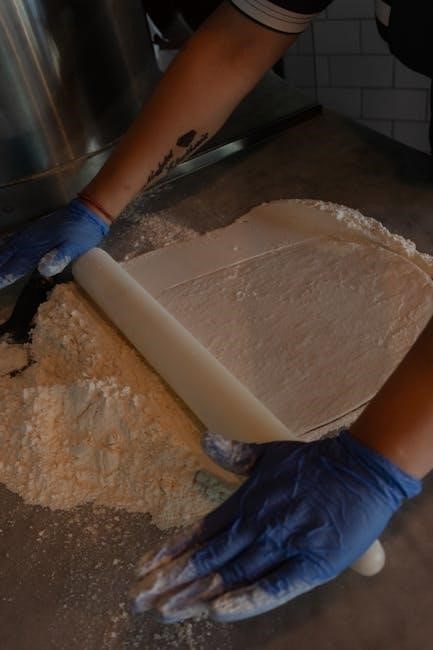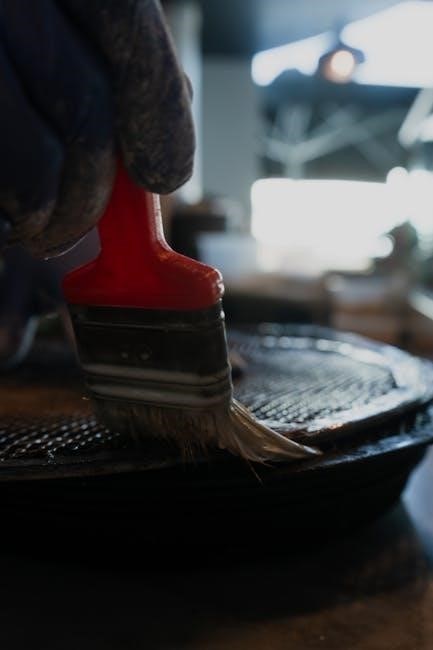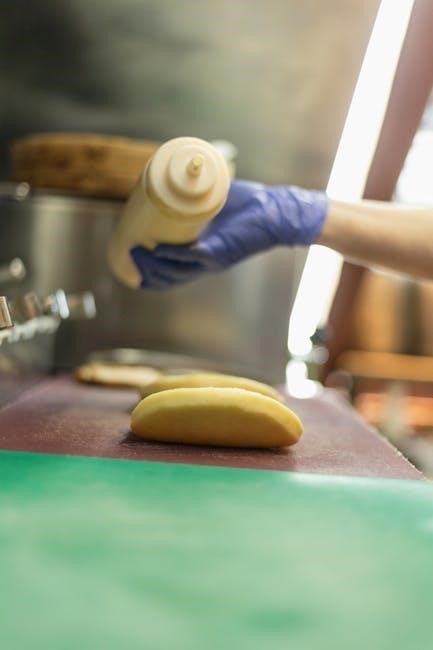Understanding glove size guides is essential for ensuring a proper fit, as ill-fitting gloves can compromise performance, comfort, and protection. This guide will walk you through measuring techniques, standard size charts, and key factors influencing glove fit to help you make informed decisions.
1.1 Why Glove Size Matters
Glove size is crucial for comfort, dexterity, and performance. Ill-fitting gloves can cause discomfort, restrict movement, or reduce grip, impacting overall functionality. Properly sized gloves ensure optimal protection, whether for sports, work, or everyday use. They prevent blisters, improve control, and enhance safety. Accuracy in sizing is key to maximizing the benefits of gloves, making it essential to understand and use reliable measurement techniques for the best fit.
1.2 How Gloves Are Sized
Gloves are sized based on hand measurements, primarily focusing on palm circumference and finger length. The process involves wrapping a tape measure around the dominant hand at its widest point, excluding the thumb, to determine the palm circumference. This measurement is then matched to a standardized size chart, which varies by manufacturer and glove type. Sizes range from small to extra-large, ensuring a snug yet comfortable fit for various activities and hand shapes.

Measuring Techniques for Glove Size
To determine your glove size, use a tape measure around your dominant hand at its widest point, below the knuckles, excluding the thumb. Make a fist to ensure accurate measurement of palm width, which guarantees the best fit for your needs.
2.1 Measuring Your Dominant Hand
To measure your dominant hand, wrap a tape measure around it at the widest point, just below the knuckles, excluding the thumb. Make a fist to ensure accuracy, as this reflects the glove’s fit. Record the circumference in inches, which corresponds to your glove size. If your measurement falls between sizes, consider sizing down for a snug fit. This method ensures optimal comfort and functionality for various glove types.
2.2 Where to Measure: Palm Circumference and Width
To determine your glove size accurately, measure the palm circumference by wrapping a tape measure around the widest part of your hand, just below the knuckles, excluding the thumb. Additionally, measure the palm width from the base of your index finger to the base of your pinky finger. These measurements help ensure a comfortable and precise fit, guiding you to the correct size in the glove size chart.
Glove Size Charts: Standard Measurements
Glove size charts provide standardized measurements, typically based on palm circumference in inches. Men’s and women’s charts differ slightly, ensuring accurate sizing for comfort and functionality.
3.1 Men’s Glove Size Chart
Men’s glove sizes typically range from 7 to 12 inches, based on palm circumference. Measure around the dominant hand at the widest point, excluding the thumb. Size 7 fits 6.5-7 inches, while size 12 fits 11.5-12 inches. Charts vary slightly by brand, so refer to specific guides for accurate sizing. Proper fit ensures comfort and functionality across various activities.
3.2 Women’s Glove Size Chart
Women’s glove sizes usually range from 6 to 9 inches, measured by palm circumference. Size 6 fits 5.5-6 inches, while size 9 fits 8.5-9 inches. Measure around the dominant hand at its widest point, excluding the thumb. Some brands offer petite or extended sizes. Always consult the specific chart for the best fit, ensuring comfort and dexterity for various activities like sports or formal wear.

Factors Affecting Glove Fit
Hand shape, finger length, and material thickness significantly impact glove fit. Proper sizing ensures optimal comfort, dexterity, and performance across various activities and glove types.
4.1 Hand Shape and Size Variations
Hand shape and size variations play a crucial role in determining the right glove fit. People with broader palms or longer fingers may require larger sizes, while those with narrower hands may prefer smaller sizes. Additionally, the circumference of the palm and the length of the fingers can vary significantly, affecting how snug or loose the gloves feel. Proper measurement ensures a tailored fit for comfort and functionality, addressing these individual differences effectively.
4.2 Thickness of Gloves and Material
The thickness of gloves and their material significantly impact fit. Thicker materials, like winter gloves or padded sports gloves, may require sizing up for comfort. Conversely, thinner materials, such as driving or fashion gloves, may fit true to size. The density of the material also affects how snugly the glove feels, so it’s important to consider both the thickness and the type of fabric when selecting your size for optimal comfort and performance.
How to Choose the Right Glove Size
Measure your hand circumference at its widest point, excluding the thumb, and refer to the size chart. For a snug fit, size down if between sizes.
5.1 Steps to Determine Your Size
To determine your glove size, start by wrapping a tape measure around your dominant hand at its widest point, just below the knuckles, excluding the thumb. Make a fist to ensure accuracy. Record the measurement in inches and compare it to the size chart. If your measurement falls between sizes, consider sizing down for a snug fit or up for a looser fit based on your preference for comfort and dexterity.
5.2 When to Size Down or Up
Size down for a snug fit if your measurement is between sizes or if you prefer tighter gloves for activities requiring precision. Size up for a looser fit if you plan to layer clothing underneath or prefer a more comfortable feel. Consider the thickness of the gloves and their intended use, as this may influence whether to adjust your size for optimal performance and comfort.

Specialty Gloves and Their Sizing
Specialty gloves, such as boxing, MMA, winter, and work gloves, have unique sizing needs. Their fit and functionality depend on specific measurements and use cases.
6;1 Boxing, MMA, and Sports Gloves
Boxing, MMA, and sports gloves require precise sizing for optimal performance and protection. Measure your dominant hand’s circumference just below the knuckles, excluding the thumb. Sizes typically range from 8 to 12 inches, corresponding to small to extra-large. Wrap a tape measure tightly around your palm while making a fist. If between sizes, consider sizing down for a snug fit to ensure proper grip and support during training or competition.
6.2 Winter, Work, and Fashion Gloves
Winter, work, and fashion gloves vary in sizing due to material thickness and intended use. Measure your dominant hand’s palm circumference at its widest point, excluding the thumb. Convert the measurement to inches and refer to size charts. Winter gloves often run larger for layering, while work gloves may require a snug fit for dexterity. Fashion gloves focus on comfort and style, ensuring a balance between fit and functionality.
Caring for Your Gloves to Maintain Fit
Proper care ensures gloves retain fit and quality. Wash with mild detergents, avoid machine drying, and store in a cool, dry place to maintain shape.
7.1 Washing and Drying Guidelines
Proper washing and drying are crucial for maintaining glove fit. Use mild soap and cold water to avoid shrinking or material degradation. Gently scrub the exterior, rinse thoroughly, and air dry away from direct heat. Avoid machine drying, as it can distort the shape. For leather gloves, condition after washing to preserve flexibility and prevent cracking. Regular care extends glove longevity and ensures optimal performance. Cleanliness and maintenance are key to retaining the perfect fit.
7.2 Storing Gloves Properly
Store gloves in a cool, dry place to maintain their shape and material integrity. Avoid direct sunlight, as it can cause fading or weakening. For leather gloves, stuffing them with paper can help retain their form. Use a breathable container or drawer to prevent moisture buildup. Avoid folding or creasing, especially for delicate materials. Proper storage ensures your gloves remain comfortable and functional, preserving their fit and extending their lifespan.
Properly fitted gloves enhance performance, comfort, and protection. Finding the right size requires effort, but using a detailed guide ensures a perfect fit every time.
8.1 Final Tips for the Perfect Fit
To achieve the perfect glove fit, always measure your dominant hand and consider the glove’s material thickness. If between sizes, size down for snugness. Ensure the tape measure is tight but not constricting when wrapped around your palm. Double-check size charts specific to the type of glove, as sizing can vary between styles. Proper fit ensures optimal comfort and functionality, making every activity more enjoyable.
Frequently Asked Questions
Common queries include how to measure hand circumference accurately, whether to size up or down, and how material thickness affects fit. Always refer to specific size charts for precise sizing guidance.
9.1 Common Queries About Glove Sizing
Common questions about glove sizing include how to accurately measure hand circumference, whether to size up or down, and how material thickness affects fit. Many wonder if they should measure their dominant hand and whether to include the thumb. Others ask about the difference between men’s and women’s sizing charts and why some gloves run smaller or larger than expected. Additionally, inquiries arise about converting measurements between inches and centimeters and ensuring the best fit for specific activities, such as sports or winter use. Proper sizing is crucial for both comfort and functionality, so it’s important to refer to detailed size charts and guidelines provided by manufacturers.

Additional Resources
For more detailed glove sizing information, explore manufacturer websites, such as RDX and LEKI, which offer comprehensive size charts and measurement guides to ensure the perfect fit.
10.1 Where to Find Detailed Size Charts
Detailed glove size charts are readily available online through manufacturer websites like RDX and LEKI. These resources provide measurements for various glove types, including sports and winter gloves. Many sites offer printable guides or step-by-step tutorials to ensure accuracy. Additionally, specific brands often include sizing tools tailored to their products, making it easier for consumers to find the perfect fit. Always refer to the manufacturer’s official size chart for the most accurate results.